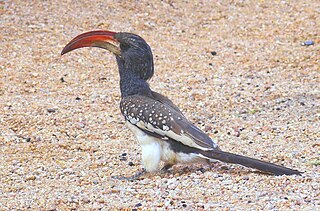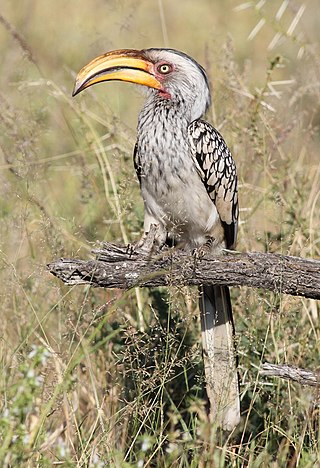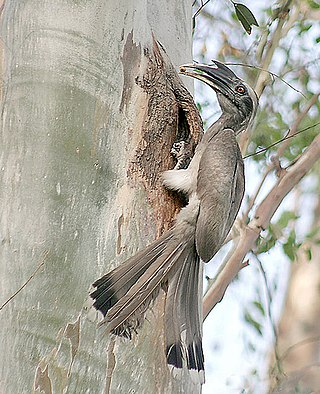
Hornbills are birds found in tropical and subtropical Africa, Asia and Melanesia of the family Bucerotidae. They are characterized by a long, down-curved bill which is frequently brightly coloured and sometimes has a horny casque on the upper mandible. Hornbills have a two-lobed kidney. They are the only birds in which the first and second neck vertebrae are fused together; this probably provides a more stable platform for carrying the bill. The family is omnivorous, feeding on fruit and small animals. They are monogamous breeders nesting in natural cavities in trees and sometimes cliffs. A number of mainly insular species of hornbill with small ranges are threatened with extinction, mainly in Southeast Asia.

Tockus is a genus of birds in the hornbill family, Bucerotidae, which are native to Africa.

The red-billed hornbills are a group of hornbills found in the savannas and woodlands of sub-Saharan Africa. They are now usually split into five species, the northern red-billed hornbill, western red-billed hornbill, Tanzanian red-billed hornbill, southern red-billed hornbill and Damara red-billed hornbill, but some authorities consider the latter four all subspecies of Tockus erythrorhynchus.

The green wood hoopoe is a large, up to 44 cm (17 in) long tropical bird native to Africa. It is a member of the family Phoeniculidae, the wood hoopoes, and was formerly known as the red-billed wood hoopoe.

The African grey hornbill is a member of the hornbill family of mainly tropical near-passerine birds found in the Old World. It is a widespread resident breeder in much of sub-Saharan Africa and the southwest of the Arabian Peninsula. The African grey hornbill has escaped or been deliberately released into Florida, USA, but there is no evidence that the population is breeding and may only persist due to continuing releases or escapes.

The Monteiro's hornbill is a species of hornbill that is native to the dry woodlands of southwestern Africa. It is a common, near-endemic species in Namibia, with a total population estimated at 340,000 individuals.

The southern yellow-billed hornbill is a hornbill found in southern Africa. Yellow-billed hornbills feed mainly on the ground, where they forage for seeds, small insects, spiders and scorpions. This hornbill species is a common and widespread resident of dry thornveldt and broad-leafed woodlands. They can often be seen along roads and water courses.

The Indian gray hornbill is a common hornbill found on the Indian subcontinent. It is mostly arboreal and is commonly sighted in pairs. It has grey feathers all over the body with a light grey or dull white belly. The horn is black or dark grey with a casque extending to the point of curvature of the horn. It is one of the few hornbill species found in urban areas in many cities where they are able to make use of large trees in avenues.

Bucerotiformes is an order of birds that contains the hornbills, ground hornbills, hoopoes and wood hoopoes. These birds were previously classified as members of Coraciiformes. The clade is distributed in Africa, Asia, Europe and Melanesia.

The black-and-white-casqued hornbill also known as the grey-cheeked hornbill, is a large black and white hornbill. It has an oversized blackish bill with a large casque on top. The female is slightly smaller than the male and has a significantly smaller casque. It is a monogamous species, and pairs nest in suitable tree cavities. The female usually lays up to two eggs. The diet consists mainly of figs, fruits, insects and small animals found in the trees.
Tomopterna ahli, commonly known as the Damaraland sand frog or Damara sand frog, is a species of frog in the family Pyxicephalidae. It is found in central to north-western Namibia and southwestern Angola.

The Benguela long-billed lark, also known as the Benguela lark or Benguela longbill is a species of lark in the family Alaudidae. It is found in south-western Africa. Its natural habitat is subtropical or tropical dry lowland grassland.

The Karoo long-billed lark or Karoo longbill is a species of lark in the family Alaudidae. It is found in southern Africa in its natural habitat of subtropical or tropical dry shrubland.

The Eastern yellow-billed hornbill, also known as the northern yellow-billed hornbill, is a species of hornbill in the family Bucerotidae. It is found in Djibouti, Eritrea, Ethiopia, Kenya, Somalia, South Sudan, Tanzania, and Uganda. It resembles the southern yellow-billed hornbill, but has blackish skin around the eyes.

The southern white-crowned shrike is a species of bird in the family Laniidae. It is found in Angola, Botswana, Mozambique, Namibia, South Africa, and Zimbabwe. Its natural habitats are subtropical or tropical dry forests and dry savannah.

The northern red-billed hornbill is a species of hornbill in the family Bucerotidae. It is found from southern Mauritania through Somalia and northeast Tanzania. There are five species of red-billed hornbills recognized, but all five were once considered conspecific and some authorities still classify the others as subspecies of Tockus erythrorhynchus.

The western red-billed hornbill is a species of hornbill in the family Bucerotidae. It is found from Senegal and Gambia to southern Mauritania and western Mali. There are five species of red-billed hornbills generally recognized now, but all five were once considered conspecific. Some authorities still categorize the group as Tockus erythrorhynchus with the remaining four as its subspecies

The southern red-billed hornbill is a species of hornbill in the family Bucerotidae, which is native to the savannas and dryer bushlands of southern Africa. It is replaced by a near-relative, the Damara red-billed hornbill, in the arid woodlands of western Namibia. All five red-billed hornbills were formerly considered conspecific.

The Tanzanian red-billed hornbill is a species of hornbill in the family Bucerotidae. It is found in central Tanzania and was discovered by Robert Glen and Sue Stolberger in Ruaha National Park All five red-billed hornbills were formerly considered conspecific.




















